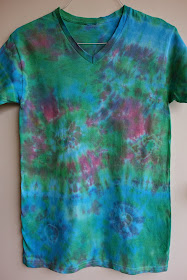Hello there! Over the weekend, I taught a crafting class to a few preteens and teenagers. The craft we worked on was tie dye t-shirts. If you haven't heard of or tried your hand at "tie dye", the name is a dead giveaway.
The "tie" part of the process is folding a t-shirt in different patterns, then tying rubber bands around it to secure the pattern. Dye {in different colors} is then added to produce another layer to the design. The result is a handmade, one-of-kind t-shirt that will surely impress friends when you say, "I made this!"
If you're curious, here's what we did:
There are many tie dye techniques available, but a tie dye kit makes the process a breeze.
Here's what you'll find inside: plastic gloves, squeeze bottles filled with pre-measured powdered dye, rubber bands, and an instruction manual.
The ideal t-shirt to use are the light colored ones with natural fibers. But go ahead and experiment with old t-shirts {blah to TADA!} or fabrics to give them a new look.
It's also suggested that the t-shirt be washed beforehand to remove sizing. Also, don't apply any fabric conditioner or dryer sheet on it. These may prevent the dye from adhering to the t-shirt.
Now it's time to tie! There are many ways to fold and create patterns on the shirt. Here are some of the ones I used:
Here is the bulls eye.
This is the stripe.
Here is the swirl.
And this is the crumple.
There are many more folding techniques that you can look up. Just make sure to tie the bands tightly.
And now the messy part.
Cover your work space with a plastic tablecloth or an inexpensive/old shower curtain because a lot of tinted splatter is expected.
As an extra precautionary layer, I used a plastic tub {ex. basin or shoe box} or large bowl that I lined with a big plastic bag {ex. garbage or shopping bag}.
Put the tied-up t-shirt inside the tub.
Then, wear the plastic gloves.
Open the squeeze bottles carefully and add lukewarm water. The more water added will yield a lighter color, the less water used produces a more intense shade.
Replace the cap tightly and shake until the dye is dissolved.
Carefully remove the cap covering the spout of the bottle. Then apply the dye to the t-shirt. Make sure the dye has penetrated into the folds. Turn the t-shirt every so often to get color on all sides.
Add the colors randomly or add a different color per section. Also, it's not necessary to dye the entire shirt. The dye will eventually spread and it's also alright to have the original color of the shirt appear in some parts.
Once satisfied, wrap the shirt in the plastic bag lining the tub/bowl. Roll it up and let it sit in a secure area {away from pets, kids or food}. Leave this alone for 6 to 8 hours {or overnight}. Allow the t-shirt to absorb the dye.
After 6 to 8 hours, you can now rinse the t-shirt under running water. You'll have to pick-up the shirt to move it around and wring it so keep you gloves handy.
You'll notice that dye will flow from the shirt. You have to rinse the shirt until no dye is present and the water runs clear.
Once the water is clear, wring the t-shirt and remove the rubber bands with scissors {these can be untied so that they can be used again}.
An important note on laundry: wash and dry tie dye projects separately from other clothes. Make sure to wash separately for the first few washes.
Here's another one.
Each one unique, each one TADA!

















No comments:
Post a Comment
Your comments are very much appreciated!